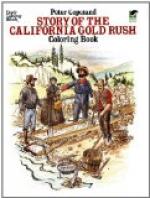San Diego, called the Mother Mission, because it is the oldest church, is now also most in ruins. But its friends hope to put new foundations under the old walls, and to recap firm ones with cement, and preserve this monument of early California history.
After Father Serra had started the San Diego settlement he set sail for Monterey. Landing at Monterey Bay, he built an altar under a large oak tree, hung the Mission bells upon the boughs, and held the usual services. The Spanish soldiers fired off their guns in honor of the day and put up a great cross. The Indians had never heard the sound of guns and were so frightened that they ran away to the mountains. The second Mission was built on the Carmel River, a little distance from the site of the first altar. This was called San Carlos of Monterey, and the settlement was the capital of Alta California for many years. It was also the Mission that Father Serra loved the best, and after every trip to other and newer settlements he returned to San Carlos as his home. This Monterey Mission is well preserved, and books, carved church furniture, and embroidered robes used in the old services are still shown.
At both San Diego and Monterey a presidio, or fort, was built for the soldiers. These forts had one or two cannon brought from Spain, and had around them high walls, or stockades, to protect, if it should be necessary, the Mission people from the Indians. The cannon were fired on holidays, or to frighten troublesome Indians.
All the Mission buildings were of brown clay made into large bricks about a foot and a half long and broad, and three or four inches thick. These bricks, dried in the sun, were called adobes, and were plastered together and made smooth by a mortar of the same clay. Then the walls were coated outside and inside with a lime stucco and whitewashed. The roof timbers were covered with hollow red tiles, each like the half of a sewer pipe, and these were laid to overlap each other so that they kept the rain out. The floors were of earth beaten hard, and the windows had bars or latticework, but no glass. The large church was snowy white within and without and had pictures brought from Spain and much carved furniture, such as chairs, benches, and the pulpit made by the Indians. One or two round-topped towers and five or six belfries, each holding a large bell, were on the church roof, and a great iron cross at the very top.
[Illustration: Mission church, Monterey.]
[Illustration: Old san Diego mission. Founded 1769.]
Night and morning the Mission bells rang to call the Indians to mass or service, and chimes or tunes were rung on holidays or for weddings. These Mission bells were brought from Spain, and it was thought a blessing rested on the ship which carried them, and that shipwreck could not come to such a vessel. We read of one captain joyfully receiving the Mission bells to take to San Diego. When nearing the coast his vessel struck a rock, yet passed on in safety because, as he said, no harm could happen with the bells on board. On his journeys every missionary carried a bell with him for the new church he was to build. Father Serra’s first act on reaching a stopping-place was to hang the bell in a tree and ring it to gather the Indians and people for service.




